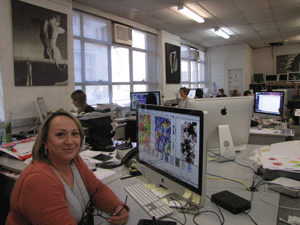Design is an asset for Longina Phillips

Climbing the well-worn timber staircase to the Surry Hills, Sydney design studio of Longina Phillips Designs and the door opens to a hive of a hive of design activity and modern technology. In the case of this busy design studio there is nothing artificial about the distressed finish to the timber stairs and flooring, it is genuine wear and tear from the traffic of hundreds of talented designers and artists that have worked in the Victorian-era terrace building since the studio opened in 1988.
Designers here create the looks that can end up anywhere from the runways of Paris and Milan to fashion sold around the world.
The busy workspace at Longina Phillips Designs is brimful of contrasts, turn a corner and you will be met with a traditional lightbox and shelves bulging with pastels and paints, while in close proximity is a state-of-the art Epson Stylus Pro 990 digital printer and RIP servers. The studio also offers direct digital printing on fabric. For founder and prinicpal Longina (Lola) Phillips, the Cumulus DAM represents a virtual sales person and opens up opportunities worldwide.
With increased competition coming from low cost labour countries Longina Phillips Design continues to thrive on design.
Founder and Managing Director Longina (Lola) Phillips is grappling with the challenges of digital workflows and secure file sharing in a Web 2.0 era, with a digital asset management (DAM) platform from Cumulus providing the platform for marketing her talented team of designers to a hungry worldwide audience.
While all of the fulltime designers paint and draw with traditional media, they work exclusively in Adobe Creative Suite to enhance and assemble their design work on a fleet of Mac workstations.
The large airy workspace is lined by shelves stacked high with rolls of fabric, reference books and craft tools, however the heart of the business now is the Windows server racks humming away at the rear of the building holding all of the company IP inside Cumulus.
Longina Phillips Designs boasts it is Australia’s leading creative print design studio. It specialises in textile and graphic design for the fashion and lifestyle industry. In 2012 it has doubled the number of Cumulus licenses to 10 and upgraded to version 8.5.2 of the DAM software.
Lola credits the Cumulus software for making a massive impact on the company in terms of improving efficiency and accessibility to key designs. It currently has 13000 designs stored inside the Canto software package. All of the images in these live online catalogues have either been scanned in or saved through Photoshop. New functions in Version 8.5.2 that the design team enjoy using include the ability to automatically send a highlighted image by email as a jpg preview.
The Spring-Summer fashions in the stores now feature designs that were completed over 12 months ago. The cycle of design and production takes around a year from the time a designer completes their design until the garment is manufactured and distributed to retail stores.

Longina Phillips’ primary market is Australia but designs are also purchased by suppliers to hot international chains such as Spain’s Zara , the UK’s TopShop or H&M or Gap in the US.
Lola’s designers are now working on the designs for 2014 using visual inspiration from a range of different sources. Predicting the hot looks that are going to be in demand in 12-18 months is not a matter of guesswork, and designers turn to market forecasting services that profile the expected hot looks, patterns and textures .
Access to this forecasting data is not cheap, and subscriptions can be between $9500 to over $30,000 p.a. for some of the online forecasting services.
This provides a digital dilemma in Lola’s attitude to the rise of social media. Longina Phillips has a presence on Facebook and Pinterest. However Lola expresses some doubts as to the business benefits of these much-hyped social platforms.
“I am not sure whether those who are following our Pinterest updates are potential customers or competitors looking for ideas.”
The design team at Longina Phillips work in close proximity to each other within an open plan environment so they have the luxury of employing the age old social platform of face to face collaboration.
“I have 1570 followers on Pinterest but most of them are fellow designers who just repin everything so it’s out there for everybody including our competition. I would be more interested in a social platform for my designers if I could keep it private for collaboration.”
“We have a longstanding Facebook presence but I have yet to see it generate any notable business. It’s still the traditional path of attending international trade fairs and direct business with clients.
“There are plenty of blogs out there using our images without crediting where they come from.”

The analogue arts are not forgotten, and the paimtbrush still has an important role in the design process.
Longina Phillips’ main online medium is a weekly email update to clients and registered users of the company blog hosted in Wordpress.
Longina Phillips adapted Cumulus Sites in 2011 and has ported a customised search interface to work with Cumulus Sites.
The firm is constantly trying to improve the DAM solution to offer their users a better user experience when browsing/searching for designs. Lola’s latest innovative was to have a customisation written that allows clients to virtually map the designs onto models (swimwear, skirts etc.) in their browser.
Development is continuous. Mobile Clients to access Cumulus via iPad/iphone are being considered at the moment. That will be a great tool when in the thick of it at industry tradeshows.
This nervousness about digital delivery extends to the external Web interface for the Cumulus DAM.
The cumulus DAM replaced an older system ran on Filemaker. A recent version upgrade delivered the ability to zoom in on thumbnail previews, however this had one unfortunate consequence.
Zooming in on the high res original resulted in a 1280 pixel wide jpg thumbnail that was of high enough quality to deliver an image that could potentially be used as a template for fabrics or clothing in countries of the world that are not that rigorous about enforcing international copyright violations.
“The previews were such high quality that unfortunately would have been sufficient for somebody looking to copy our designs, so we have disabled the zoom feature,” said Lola.
Local distributor DataBasics is working on working on adapting this functionality to also provide watermarking capability.
Lola personally monitors all of the requests for new Cumulus customer accounts that arrive via the web page.
“I prefer to contact people directly when they ask to setup a login account to ensure they are a genuine buyer.
“It’s a lot of trouble to chase down counterfeiters after they have downloaded or designs,” said Lola.
“Apart from the time and effort there are the legal costs of enforcing copyright, it costs me $1600 for the first letter from our lawyers and $1700 for the one after that.”
FileMaker is used as a CRM application and for sales tracking and MYOB for financials.
Each designer works in a traditional folder structure on the network until a design has been finalised it is placed into the DAM
The process of applying metadata to images is automated by a popup menu that adds the designer’s name, target market and technique when image files are dragged into Cumulus.
Sharing large files with customers is usually accomplished via YouSendIt, MailBigFile or DropBox or ftp.
